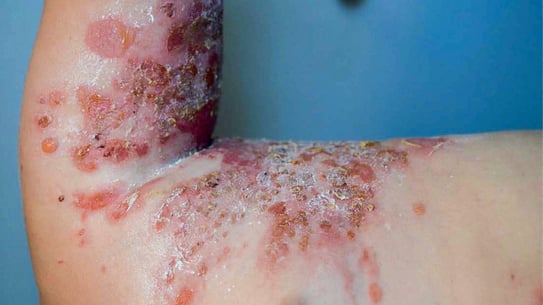0 professionals
Tom, 10 years old, Bullous eruption
Tom, 10 years old, Bullous eruption
URL copied
Written with the participation of FDVF (Future Dermatologists and Venereologists of France) interns.
Related topics


30 respondents
Question of 1
Pemphigus
Wrong answer!
It was bullous impetigo.
Let’s rule out differential diagnoses:
This is a rare condition but it can affect children; the bullae are fragile and the skin is not erythematous; most often, only post-bullous erosions are seen. The presence of mucosal involvement will aid the diagnosis. The appearance can be misleading and the outcome will not be favourable following antibiotic therapy, which will require a skin biopsy.
The symptoms are intense. There is deterioration of the overall condition and the child is exhausted. Semiologically, there is “wet laundry” detachment with Nikolsky’s sign on intact skin and mucosal involvement. This is a dermatological emergency that requires immediate hospitalisation.
Shingles in children is uncommon. The primary lesion is a vesicle that develops into clusters on inflammatory skin. The pattern is metameric. Pain and burning are the primary symptoms. A swab sample can be taken for an HSV PCR test if there is any doubt about the diagnosis.
Bullous impetigo
Bullous impetigo
It is indeed bullous impetigo.
Let’s rule out differential diagnoses:
This is a rare condition but it can affect children; the bullae are fragile and the skin is not erythematous; most often, only post-bullous erosions are seen. The presence of mucosal involvement will aid the diagnosis. The appearance can be misleading and the outcome will not be favourable following antibiotic therapy, which will require a skin biopsy.
The symptoms are intense. There is deterioration of the overall condition and the child is exhausted. Semiologically, there is “wet laundry” detachment with Nikolsky’s sign on intact skin and mucosal involvement. This is a dermatological emergency that requires immediate hospitalisation.
Shingles in children is uncommon. The primary lesion is a vesicle that develops into clusters on inflammatory skin. The pattern is metameric. Pain and burning are the primary symptoms. A swab sample can be taken for an HSV PCR test if there is any doubt about the diagnosis.
Lyell’s syndrome
Wrong answer!
It was bullous impetigo.
Let’s rule out differential diagnoses:
This is a rare condition but it can affect children; the bullae are fragile and the skin is not erythematous; most often, only post-bullous erosions are seen. The presence of mucosal involvement will aid the diagnosis. The appearance can be misleading and the outcome will not be favourable following antibiotic therapy, which will require a skin biopsy.
The symptoms are intense. There is deterioration of the overall condition and the child is exhausted. Semiologically, there is “wet laundry” detachment with Nikolsky’s sign on intact skin and mucosal involvement. This is a dermatological emergency that requires immediate hospitalisation.
Shingles in children is uncommon. The primary lesion is a vesicle that develops into clusters on inflammatory skin. The pattern is metameric. Pain and burning are the primary symptoms. A swab sample can be taken for an HSV PCR test if there is any doubt about the diagnosis.
VZV infection
Wrong answer!
It was bullous impetigo.
Let’s rule out differential diagnoses:
This is a rare condition but it can affect children; the bullae are fragile and the skin is not erythematous; most often, only post-bullous erosions are seen. The presence of mucosal involvement will aid the diagnosis. The appearance can be misleading and the outcome will not be favourable following antibiotic therapy, which will require a skin biopsy.
The symptoms are intense. There is deterioration of the overall condition and the child is exhausted. Semiologically, there is “wet laundry” detachment with Nikolsky’s sign on intact skin and mucosal involvement. This is a dermatological emergency that requires immediate hospitalisation.
Shingles in children is uncommon. The primary lesion is a vesicle that develops into clusters on inflammatory skin. The pattern is metameric. Pain and burning are the primary symptoms. A swab sample can be taken for an HSV PCR test if there is any doubt about the diagnosis.
When there are only a few scattered lesions, treatment with topical antibiotics such as fusidic acid or mupirocin can easily be considered in combination with a local antiseptic. One application per day for around 10 days will be sufficient to achieve healing.
For more extensive forms, treatment with oral antibiotics as monotherapy will be necessary. Classes that act on Streptococcus pyogenes and Staphylococcus aureus should be used. Amoxicillin + clavulanic acid is the most commonly used combination; in the event of allergy, pristinamycin or clindamycin should be used.
Create easily your professional account
I create my accountAccess exclusive business services unlimited
Access valuable features : audio listening & tools sharing with your patients
Access more than 150 product sheets, dedicated to professionals